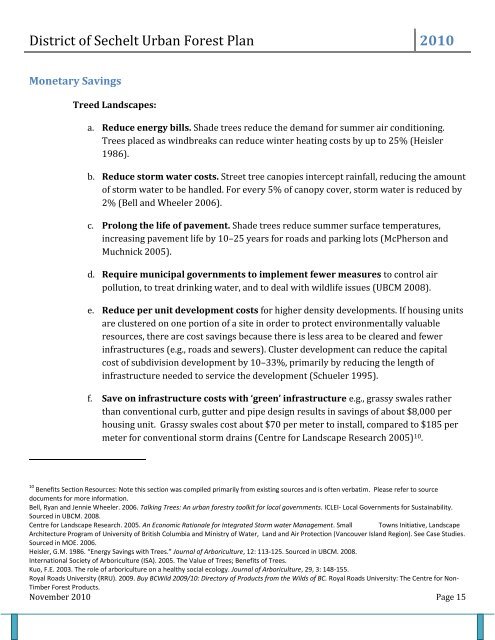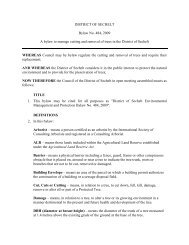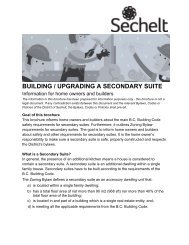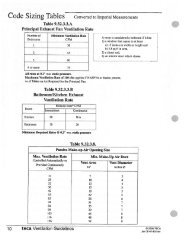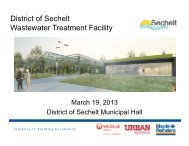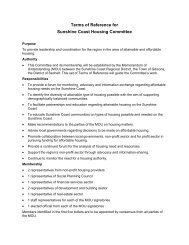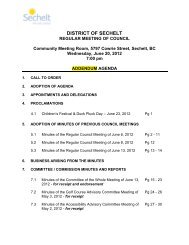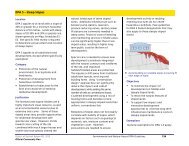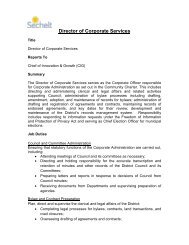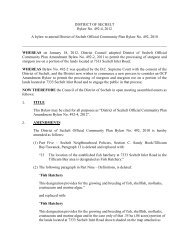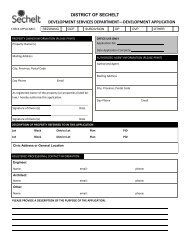District of Sechelt Urban Forest Plan
District of Sechelt Urban Forest Plan
District of Sechelt Urban Forest Plan
Create successful ePaper yourself
Turn your PDF publications into a flip-book with our unique Google optimized e-Paper software.
<strong>District</strong> <strong>of</strong> <strong>Sechelt</strong> <strong>Urban</strong> <strong>Forest</strong> <strong>Plan</strong> 2010<br />
Monetary Savings<br />
Treed Landscapes:<br />
a. Reduce energy bills. Shade trees reduce the demand for summer air conditioning.<br />
Trees placed as windbreaks can reduce winter heating costs by up to 25% (Heisler<br />
1986).<br />
b. Reduce storm water costs. Street tree canopies intercept rainfall, reducing the amount<br />
<strong>of</strong> storm water to be handled. For every 5% <strong>of</strong> canopy cover, storm water is reduced by<br />
2% (Bell and Wheeler 2006).<br />
c. Prolong the life <strong>of</strong> pavement. Shade trees reduce summer surface temperatures,<br />
increasing pavement life by 10–25 years for roads and parking lots (McPherson and<br />
Muchnick 2005).<br />
d. Require municipal governments to implement fewer measures to control air<br />
pollution, to treat drinking water, and to deal with wildlife issues (UBCM 2008).<br />
e. Reduce per unit development costs for higher density developments. If housing units<br />
are clustered on one portion <strong>of</strong> a site in order to protect environmentally valuable<br />
resources, there are cost savings because there is less area to be cleared and fewer<br />
infrastructures (e.g., roads and sewers). Cluster development can reduce the capital<br />
cost <strong>of</strong> subdivision development by 10–33%, primarily by reducing the length <strong>of</strong><br />
infrastructure needed to service the development (Schueler 1995).<br />
f. Save on infrastructure costs with ‘green’ infrastructure e.g., grassy swales rather<br />
than conventional curb, gutter and pipe design results in savings <strong>of</strong> about $8,000 per<br />
housing unit. Grassy swales cost about $70 per meter to install, compared to $185 per<br />
meter for conventional storm drains (Centre for Landscape Research 2005) 10 .<br />
10 Benefits Section Resources: Note this section was compiled primarily from existing sources and is <strong>of</strong>ten verbatim. Please refer to source<br />
documents for more information.<br />
Bell, Ryan and Jennie Wheeler. 2006. Talking Trees: An urban forestry toolkit for local governments. ICLEI- Local Governments for Sustainability.<br />
Sourced in UBCM. 2008.<br />
Centre for Landscape Research. 2005. An Economic Rationale for Integrated Storm water Management. Small Towns Initiative, Landscape<br />
Architecture Program <strong>of</strong> University <strong>of</strong> British Columbia and Ministry <strong>of</strong> Water, Land and Air Protection (Vancouver Island Region). See Case Studies.<br />
Sourced in MOE. 2006.<br />
Heisler, G.M. 1986. “Energy Savings with Trees.” Journal <strong>of</strong> Arboriculture, 12: 113-125. Sourced in UBCM. 2008.<br />
International Society <strong>of</strong> Arboriculture (ISA). 2005. The Value <strong>of</strong> Trees; Benefits <strong>of</strong> Trees.<br />
Kuo, F.E. 2003. The role <strong>of</strong> arboriculture on a healthy social ecology. Journal <strong>of</strong> Arboriculture, 29, 3: 148-155.<br />
Royal Roads University (RRU). 2009. Buy BCWild 2009/10: Directory <strong>of</strong> Products from the Wilds <strong>of</strong> BC. Royal Roads University: The Centre for Non-<br />
Timber <strong>Forest</strong> Products.<br />
November 2010 Page 15


